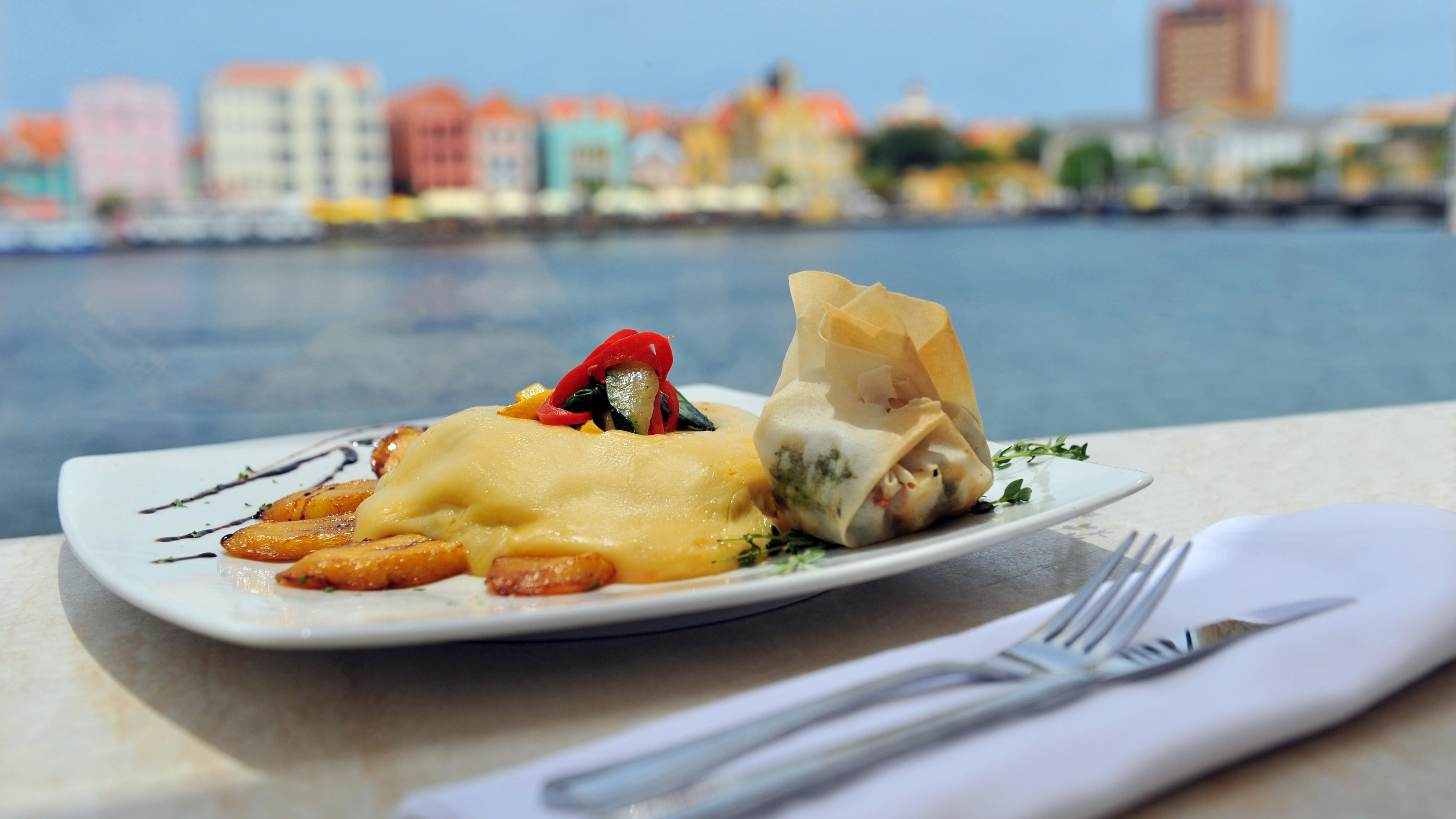How This Gooey Plate Of Cheese Became Curaçao's National Dish
Keshi yena, a 17th-century creation, reflects the island's unique culture.
The landscape of Curaçao might not be what comes to mind when you think of Caribbean island nations. Electric blue waves lapping at pearly sand beaches give way to cactus-dotted plains. The architecture features a dramatic floating bridge and candy-colored Dutch colonial buildings, with artful murals everywhere in between. You might know Curaçao primarily for its namesake blue liqueur, but strolling through the streets of the vibrant capital of Willemstad, I learned that Curaçao's cuisine reflects more than the blue sea. Each dish has developed from unlikely pairings, a testament to everything the island has endured.
The colors of Curaçao
Willemstad is divided into two parts: Punda, which is the main shopping area, and Otrobanda. The Punda side contains the splashy hues of the colonial buildings that made me feel like I was wrapped in rainbows. The story goes that Willemstad buildings used to be painted stark white until a 19th-century governor complained that gazing at the white structures under the glaring tropical sun gave him migraines. He ordered the citizens to paint their houses any color but white, and as a result, the city's color-drenched coral stone and sand buildings quickly became its signature, helping Curaçao stand out from the surrounding islands. It was later discovered that the headache-prone governor was also a stakeholder in the island's only paint shop.
With 50 nationalities represented on the island, the locals speak English, Dutch, and Spanish, but the main language is Papiamento, the multi-layered Creole that blends words from Portuguese, Spanish, Dutch, and several African languages. I learned many Papiamento words while sampling the sweet and savory flavors of Curaçaoan dishes.
Sampling Curaçao flavors
The first was the popular street food, pastechi. These fried and stuffed dough pockets, similar to empanadas, are essential on the island, sold in roadside stands called sneks and filled with cheese, tuna, beef, or bakijou, the Papiamento word for salted cod. I washed down the flaky crust with a batido, a smoothie made with condensed milk and fresh tropical fruits like tamarind, passionfruit, or guava. At night, Curaçao hosts a thriving scene of clubs, bars, and restaurants serving a mix of international dishes and local faves like karni stoba, a thick and tangy beef stew with potatoes and green papaya. But the ultimate nighttime meal is at the BBQ Express truk di pan, or food truck.
Food trucks were a Curaçao staple decades before the trend reached the U.S., and the late-night scene is packed with hungry customers lining up for a meal after a night of partying. BBQ Express stood out from the other trucks, with long lines and tables and chairs neatly scattered around the truck. The signature dish is galina ku batata, perfectly grilled chicken with heaps of fries. It might sound ordinary, but the local practice of covering the platter with garlic sauce, peanut sauce, and rosada (ketchup mixed with mayo) packs an unforgettable explosion of sweet and savory.
When I asked about Curaçao's national dish, some pointed to yuana, iguana stew. But when I saw the large hunks of flesh floating in a heavy liquid, I was happy to hear that the complex keshi yena is also considered a signature meal.
What is keshi yena?
The papiamento words "keshi yena" translate to "stuffed cheese," and it's nothing like anything I've eaten before. It's not meat stuffed with cheese, but rather cheese stuffed with an unusual assortment of chicken, olives, raisins, spices, and sometimes prunes. The dish was developed in the 17th century when the Dutch West India Company used Curaçao as the gateway to the the Atlantic slave trade in South America and the Caribbean. Enslaved Africans took the discarded rinds of the gouda and edam cheese that the Dutch loved, stuffed them with leftover meats and vegetables, and baked the dish until the cheese melted.
I sat on the veranda of the iconic Gouverneur restaurant overlooking Sint Anna Bay and the handelskade waterfront when the butter-yellow mound was set before me. Stylishly plated with slices of cassava and plantains and topped with a spray of arugula, it looked like a gourmet art piece. I sliced into it and bits of chicken and olives oozed out. I placed a forkful in my mouth and I was in love.
The mildness of the gouda cheese cushioned the texture of the chicken and olives, and the sweetness of the prunes and raisins somehow complemented it all. I can't explain why, it was just a heavenly taste sensation. I dug into the cheese and its puddle of tomato-based creole sauce until I felt like I would burst. Looking at the melted cheese and the array of different fixings, it occurred to me that Curaçao is literally and figuratively a true melting pot of the unexpected.
